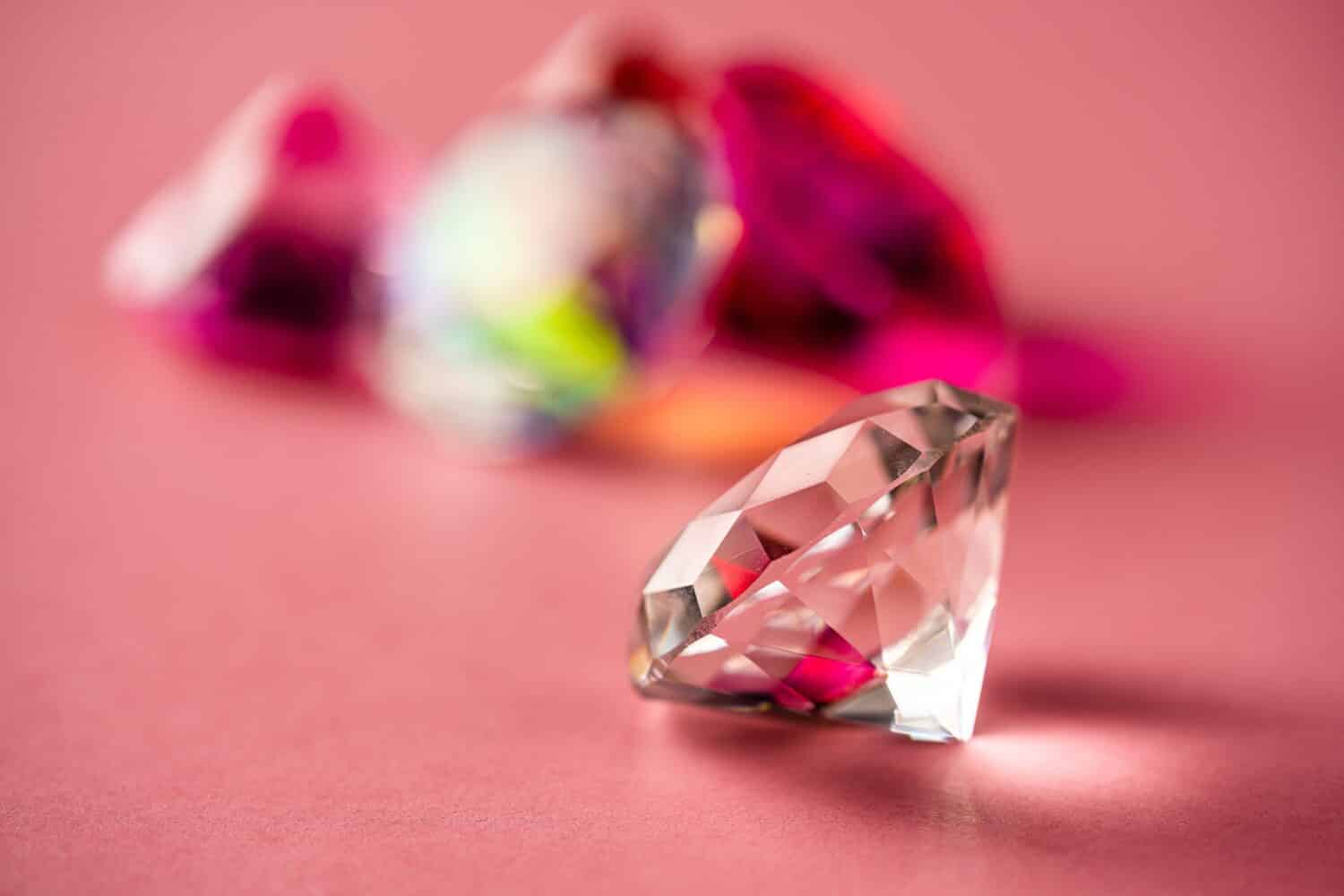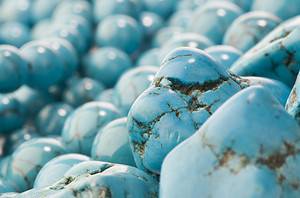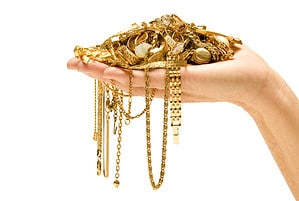Whether you’re looking for your next diamond-alternative jewelry piece or are more interested in the geology of precious stones and gems, you may have wondered about stones that look like diamonds. As it turns OUT, several stones fall into this category. Below, explore what makes a diamond a diamond. Then, learn more about the five stones that look like diamonds.
Ready to learn more? Let’s dive right in!
What is a Diamond?

A diamond is a precious stone formed when carbon undergoes extreme pressure and heat.
©DiamondGalaxy/Shutterstock.com
Although you may be familiar with diamonds in jewelry and accessories, you may not know much about this precious stone in a more natural context.
A diamond is a solid form of carbon, one of the elements in the periodic table. There are other forms of carbon, like graphite, that form under different conditions than diamonds. Of all natural materials, diamonds have the highest hardness and thermal conductivity. Because of this, not only are they used in jewelry, but they also make exceptional tools used in cutting and polishing. On the Mohs hardness scale, diamonds receive the highest rating of 10.
Typically, diamonds are mined from the ground. However, alternatives have been created because this is hazardous, expensive work. This includes the invention of lab-grown diamonds. These diamonds are made using a similar method to natural diamonds, except the process is done in a controlled environment. Scientists will take pure carbon and expose it to intense pressure and heat, which results in the crystallization that forms the beloved diamond.
Natural diamonds can come in various colors depending on how they are formed. However, colorless diamonds are the most well-known.
5 Stones That Look Like Diamonds
Although diamonds have a unique process and chemical makeup, several stones look like diamonds. Below, explore five of these stones and learn more about their appearance, formation, and hardness compared to the diamonds.
Moissanite

Although commonly synthetic, moissanite is one of the stones that look like diamonds, most similar to precious stones.
©Tkachenkoproduction/Shutterstock.com
When considering jewelry, there are often two stones considered the most similar to diamonds in appearance. From a scientific perspective, only one is made similarly to the diamond, while the other, though made differently, is also considered one of the few precious stones. These two diamond look-alikes are moissanite and white sapphire.
Like diamonds, moissanite is a naturally occurring material. This stone occurs when carbon and silicon are exposed to high pressure and heat. While it doesn’t come in as many colors as the diamond, it has a similar colorless appearance and rarer shades of yellow and green. It ranks 9.25 on the Mohs hardness scale. Because large-sized moissanite is extremely rare, much of the moissanite you see used in jewelry is lab-grown.
While colorless moissanite and colorless diamonds are extremely similar, they also differ. One of the biggest differences is the reflection when used in jewelry. Due to the way that stones are cut for rings and other forms of jewelry, they reflect light. This is what gives them their glittery, beguiling appearance. Colorless diamonds will give off a white reflection. Moissanite, however, has a rainbow-like reflection.
White Sapphire
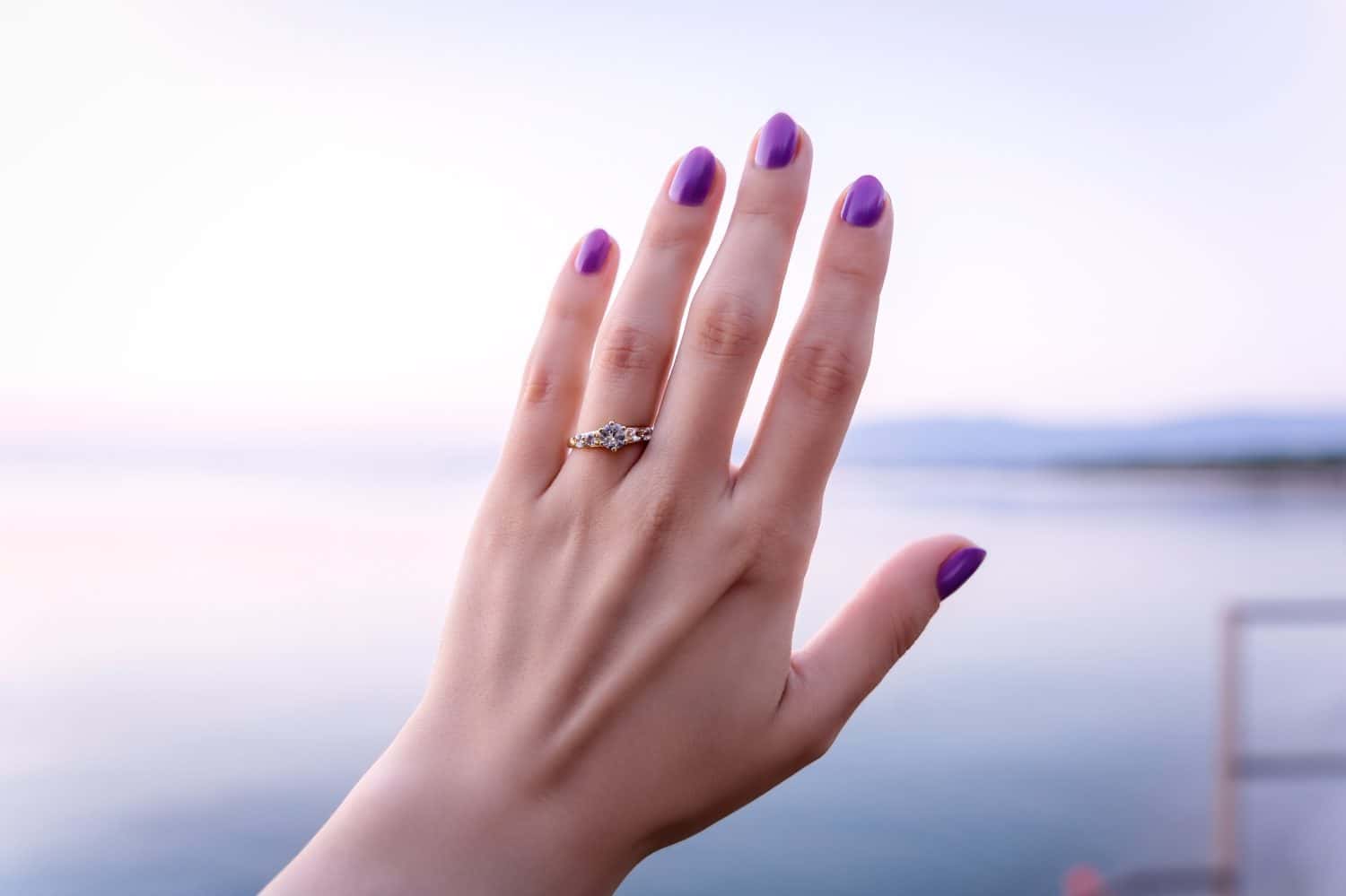
Sapphires are any corundum that is not red.
©Johana Mlichova/Shutterstock.com
When you think of a sapphire, you likely think of brilliant blue stones. As it turns out, however, sapphire is a type of gem-quality corundum. Red Corundum is considered a ruby; all non-red corundum is considered sapphire. As a result, while white sapphire may not hold that familiar blue hue because it is not red, it is regarded as a sapphire.
Sapphires, like diamonds, are one of very few true precious stones. White sapphires, in particular, are famed for their overall pure nature. Because of their colorless appearance, you can know that nothing has been introduced to alter their appearance, such as glass.
Compared to diamonds, white sapphires have less of a prominent sparkle. This is known as the Refractive Index (RI) in jewelry. As a result, whereas a diamond may still appear brilliant under grim, a white sapphire will need to be cleaned more often for its beautiful shine. However, these stones are fairly equal in terms of the Mohs hardness scale. White sapphire often ranges from a 9 to a 10.
Cubic Zirconia

Cubic zirconia is synthetically formed by a mixture of various compounds and elements before being exposed to heat.
©Finesell/Shutterstock.com
It is important not to mistake cubic zirconia (CZ) with white zircon. Both of these are stones that look like diamonds, but they differ vastly. Cubic zirconia is the crystalline form of zirconium dioxide (ZrO2). Whereas sapphires and diamonds are known as precious stones, cubic zirconia is an oxide mineral.
Much of the cubic zirconia you find in jewelry like moissanite is synthetic. Its production began in 1976. Since then, it has been considered an essential, budget-friendly alternative to diamonds in jewelry. However, while its colorless appearance is similar to that of a diamond, it does have the lowest Mohs scale score thus far on this list. The hardness of a cubic zirconia sits at 8.0 to 8.5. While this is lower than the diamond, moissanite, or white sapphire, the hardness of this score is still suitable for day-to-day wear in jewelry.
In its natural form, zirconia is a powder that is used for a wide variety of purposes, including ceramics. Zirconium oxide, an oxide of zirconia, is mixed with other materials to form these crystals. This often includes those such as magnesium and calcium. This mixture is then heated. Once removed from the heat, the crystals that later become cubic zirconia are formed.
White Zircon
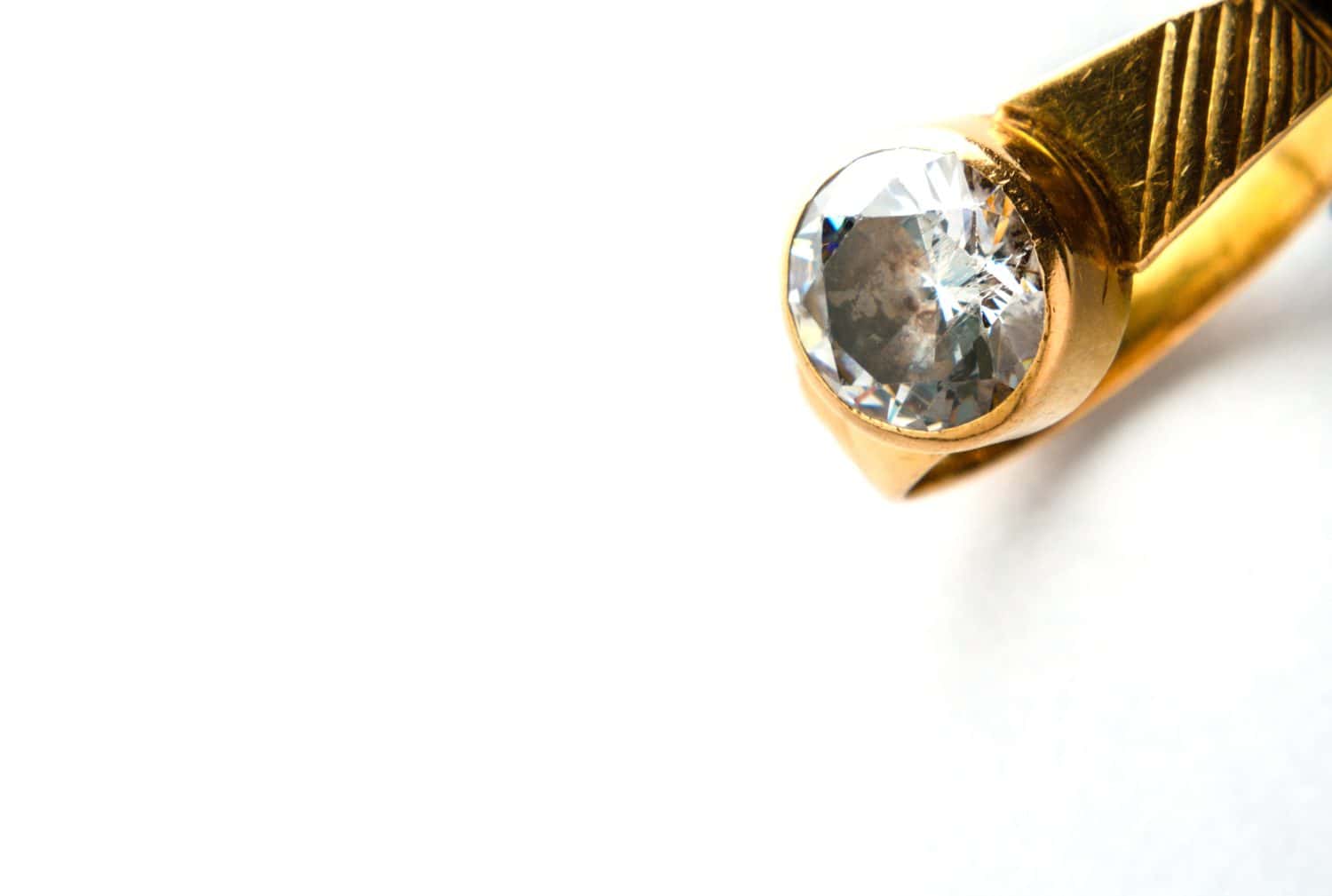
White zircon is often used in jewelry and ceramics, including dentistry.
©Roy_Photos/Shutterstock.com
As learned above, cubic zirconia is an artificial material. It does not occur in nature because it needs to be stabilized with magnesium and calcium under extreme heat. This is not true for white zircon, so it is important not to confuse the two.
White zircon is mined, much like diamonds and white sapphire are. Areas abundant in this stone that looks like a diamond include East Africa and Cambodia. Naturally, white zircon may not be purely colorless or white. However, when heated, the stone gains its diamond-like appearance. Like cubic zirconia, it has been used as a budget-friendly diamond alternative for several decades.
Despite being a natural material rather than synthetic, white zircon has a lower Mohs hardness than cubic zirconia. This makes it one of the weaker stones that look like diamonds on this list. However, despite not being as strong as diamonds or moissanite, white zircon has a Mohs hardness score of around 7 to 7.5. For reference, a steel nail has a Mohs hardness score of about 6.5.
White Topaz
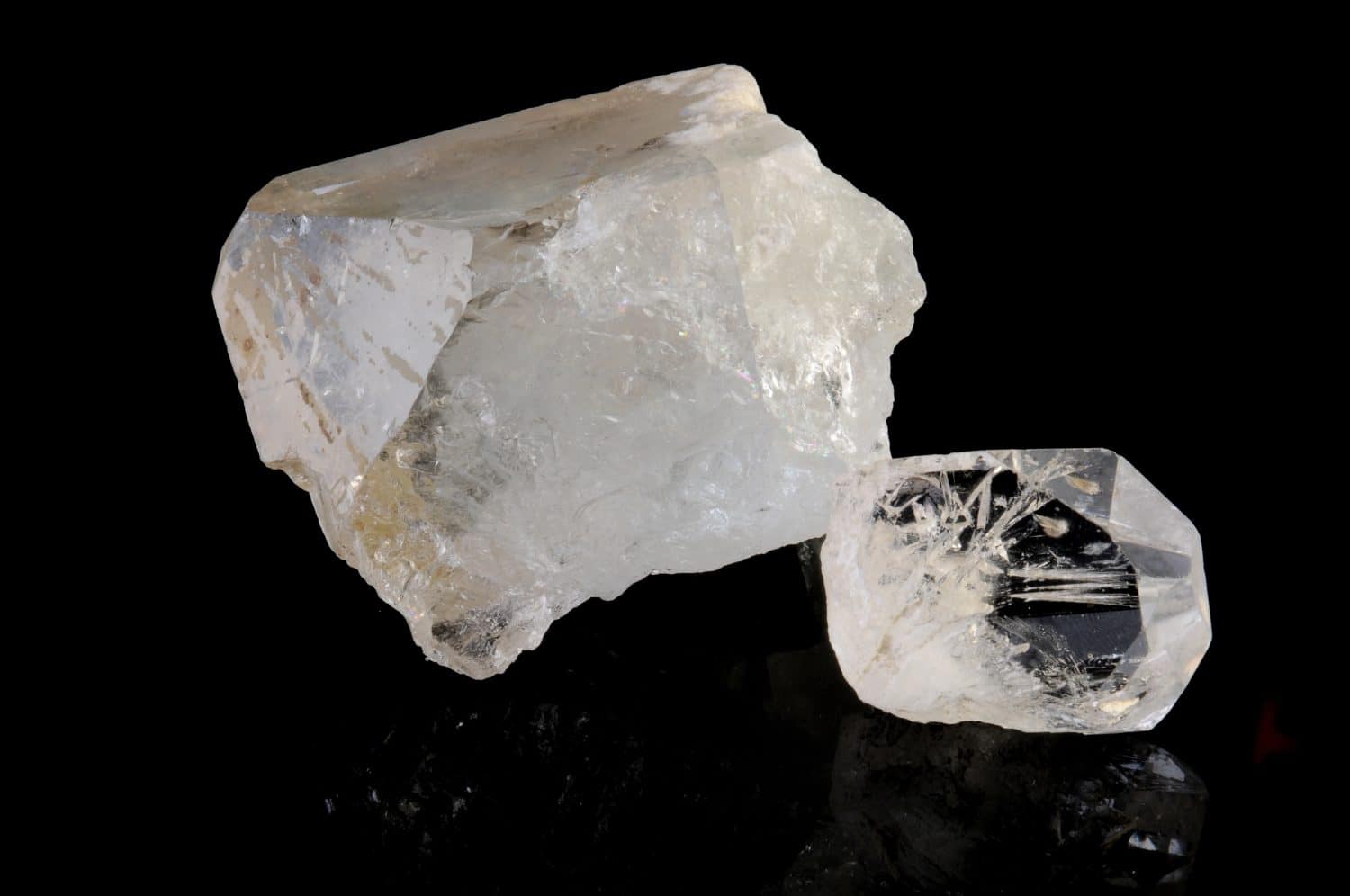
Topaz often forms near igneous rocks.
©Yenfiz/Shutterstock.com
White topaz is also known as clear or silver topaz. While it ranks eight on the Mohs hardness scale, cleaning can be difficult. This is because the stone is easily discolored, especially by cleansers. However, regarding day-to-day durability against scratches and fractures, white topaz is on par with cubic zirconia.
This stone is found naturally throughout different regions of the world. Some areas include the United States, Brazil, Russia, Mexico, and China. It is found most commonly in the fractures of cavities of igneous rocks. Topaz grows during the later stages as magma cools. This is because enough fluorine is present to help stabilize the chemicals and form white topaz crystals. Because topaz requires cooling magma and volatile elements like fluorine, it is one of the last crystals to form at the site of magma.
White topaz, in particular, is a colorless variety of topaz. It is the most common of topaz stones.
Thank you for reading! Have some feedback for us? Contact the AZ Animals editorial team.

